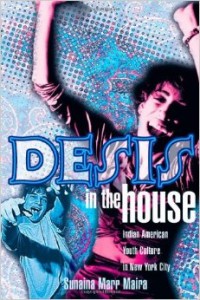 There is a scene in the film American Desi (2001) where one of the characters, Jagjit, reads aloud the following sentence from a campus newspaper: “The Indian club is dedicated to promoting Indian culture and organizes various events throughout the year, including a Diwali show, Bhangra night, and Navratri Garbha” (39:58). His tone at the start of this sentence is neutral and free of drama — as he reaches the word “Bhangra night,” though, there is a sudden, momentary peak in interest and lift to his voice. After this explosion of enthusiasm, his tone relaxes back down as he finishes the sentence. Why the sudden lift in his voice when he perceives the word “bhangra”? What makes it so much more exciting than the other cultural events? How could we theorize the sheer delight in his voice?
There is a scene in the film American Desi (2001) where one of the characters, Jagjit, reads aloud the following sentence from a campus newspaper: “The Indian club is dedicated to promoting Indian culture and organizes various events throughout the year, including a Diwali show, Bhangra night, and Navratri Garbha” (39:58). His tone at the start of this sentence is neutral and free of drama — as he reaches the word “Bhangra night,” though, there is a sudden, momentary peak in interest and lift to his voice. After this explosion of enthusiasm, his tone relaxes back down as he finishes the sentence. Why the sudden lift in his voice when he perceives the word “bhangra”? What makes it so much more exciting than the other cultural events? How could we theorize the sheer delight in his voice?
For those of us growing up in the 1990s, “bhangra night” may recall a radically popular space enjoyed by second-generation South Asian immigrants. The ‘Desi dance party’ was a distinctive diasporic youth culture, perhaps most famous for attracting and embodying the cultural multiplicity experienced by children of immigrants. It came alive in the United States in the 1990s as local, mostly city-based, circuits of dance parties, attended by the same group of people in the know and their own informal social networks.
At its peak as a “subculture,” it drew almost exclusively a South Asian youth audience, but became mainstream over the 2000s, especially attracting an urban hipster crowd. Drawing heavily from the genres of bhangra pop, desi film music, dancehall, reggae, and hiphop, the form involves DJs creatively “mixing” beats from songs belonging to entirely different musical traditions to the benefit of adoring, dancing audiences. There was clearly some influence here from British Bhangra; at the same time, I would argue, the scene responded to more American-specific cultural values and neoliberal demands on the individual.
The popularity of these parties among second-generation desis has been interesting from a cultural perspective. In her book on this party culture in the New York area — Desis in the House — Sunaina Maira argues that notions of “how to be cool” and those of “how to be authentically” desi in the context of second-generation youth collided and were performatively worked out within these parties. So, for Maira, the youth culture reflected the tensions between being ‘cool’ vs. ‘culturally authentic’ these youth grapple with in their everyday lives.
To make these arguments about the subculture, Maira draws upon her interviews with these young party-goers about aspects of their lives — primarily their South Asian affiliations (and tensions within about authenticity), their middle-class family’s expectations of them to become professionals, and the way they saw hip hop as a form of cool defiance but also simultaneously disavowed any racial politics or affinity with Black Americans. Maira’s claims in this book are complex, intricate, and verifiable, but they all bear the underlying premise that the construction of identity is the central purpose or cultural work performed at the parties.
 Maira is right to argue that these tensions predominated larger discourses about these kids’ lives, and she has beautifully theorized this vector within these youth’s lives that chases authenticity and the need to negotiate multiplicity within these parties. Yet she does not account for the death drive, if you will, for these dramas of the self. What if, I ask, they are going to these parties to escape some of the pressures of creating viable, legible identities? What if the parties were a place where one did not have to care about self-performance?
Maira is right to argue that these tensions predominated larger discourses about these kids’ lives, and she has beautifully theorized this vector within these youth’s lives that chases authenticity and the need to negotiate multiplicity within these parties. Yet she does not account for the death drive, if you will, for these dramas of the self. What if, I ask, they are going to these parties to escape some of the pressures of creating viable, legible identities? What if the parties were a place where one did not have to care about self-performance?
It is extremely possible that young people went to these parties, as Maira has persuasively presumed, to construct identities and manage their cultural multiplicity just like they do in all avenues of their lives like college, family life, religious organizations, with friends to smoke pot, etc. However, the exceeding popularity of this popular cultural form vs. all of the other collective social spaces in their lives begs its distinctiveness, or even rebelliousness, that a theory about constructions of cultural identity does not address. Even among Maira’s interview subjects, the parties are seen as a form of guilty pleasure and, like most nightlife experiences, a source of temporary relief from the pressures of daytime labor.
Guilty pleasures, however temporary, perform important cultural work and are especially valuable for what they tell us about the human experience outside politics of representation. Indeed, Desi dance parties show up as a different form of social outlet in American Desi or Tanuja Desai Hidier’s 2002 novel, Born Confused, both texts clearly emerging from and attuned to a 1990s South Asian American youth culture. In a larger project, I closely read these two fictional texts to consider how, instead of collective identity making, the parties could have offered moments of respite and detraction from its pressures. At these parties, the kids are no longer code switching. They finally don’t even need to talk about who they are and where they/their parents are from.
Neoliberalism relies on identity politics in so many ways; “cultural traditions” are more often than not marketplace tools. Minorities especially are compelled to consume and purchase expressions and lifestyle models of Americanness or chic Desi-ness in order to display and claim their belonging. This is part of the “self-care” that neoliberal subjects must master and publicly exhibit to be treated as good citizens.
Secondly, there is a lot of social capital to be had by second-generation youth who deploy their ethnic identity to fit the neoliberal model, and the imperatives of professionalization and partaking in the middle class create stakes for their American/cultural belonging. In this context, the parties may have voiced resentment about the identity labor they need to perform in their everyday lives. If that is even a remote possibility, the ‘90s desi dance party emerges as a space of remove from the (neoliberal and immigrant-communal) demands upon them to maintain a legible cultural identity at all times or code switch between different ones.
* * *
Swathi Sreerangarajan is an English Ph.D. candidate at the University of Pittsburgh and a predoctoral diversity fellow at South Dakota State University for the year 2014-15, with her main residence in the San Francisco Bay Area. Her research focuses on the ways second-generation South Asian immigrants growing up in the 1980s and 1990s have produced and consumed literary and popular American culture. Her dissertation unpacks the ways this rich cultural material interacts with U.S. identity politics and immigrant/diasporic fantasies. She is also completing doctoral certificates in gender, sexuality, and women’s studies and Asian Studies offered by respective departments at the University of Pittsburgh.












